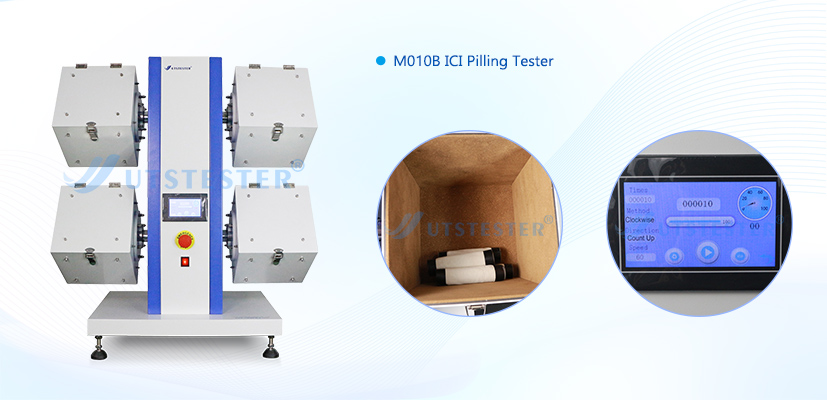La durabilidad de los textiles es crucial para garantizar la satisfacción del cliente y la longevidad del producto. Al someter los textiles a rigurosas pruebas, este instrumento ayuda a los fabricantes a identificar y abordar posibles problemas relacionados con la formación de bolitas y los enganches, mejorando así la calidad del producto.
1. La importancia de la durabilidad de los textiles
La durabilidad de los textiles es un factor clave que incide directamente en la satisfacción del cliente y su vida útil. Cuando los textiles presentan señales de pilling o desgarros, su atractivo estético se ve significativamente reducido y su funcionalidad se ve comprometida. Por ello, los fabricantes se esfuerzan por desarrollar textiles con una durabilidad excepcional para satisfacer las expectativas del consumidor y mantener una ventaja competitiva en el mercado.
2. Principio de prueba:
Coloque el tubo de muestra con la muestra de prueba en la cámara de prueba de pilling. Active el instrumento, permitiendo que las muestras giren y se froten entre sí dentro de la cámara. Después del número especificado de ciclos de giro, retire las muestras para su clasificación.
3. Preparación de la muestra:
(1) Pretratamiento: Si se requiere pretratamiento, las muestras pueden lavarse o limpiarse en seco mediante métodos acordados mutuamente por ambas partes. (Se recomienda el pretratamiento para proteger las superficies de fricción de la cámara de pilling y los tubos de muestra de los residuos de lubricantes o agentes de acabado en el tejido).
(2) Corte cuatro muestras de 125 mm × 125 mm de la muestra de tela. Además, corte una pieza idéntica como muestra de referencia para la clasificación. Doble dos muestras a lo largo con el derecho hacia adentro y dos a lo ancho con el derecho hacia adentro. Cosa cada pliegue a 12 mm del borde con una máquina de coser.
(3) Voltee las muestras cosidas. Recorte los orificios de 6 mm en ambos extremos del tubo de muestra para eliminar la distorsión de la costura. Deslice la muestra sobre el tubo de poliuretano y fíjela con cinta de PVC (dejando expuestos 6 mm de poliuretano en cada extremo; la longitud de la cinta no debe exceder 1,5 veces la circunferencia del tubo).
(4) Humedecer.
4. Procedimiento de prueba:
(1) Limpie la cámara de pilling.
(2) Coloque cuatro tubos de muestra con muestras adjuntas en la cámara, cierre bien la tapa y ajuste el contador al recuento de rotaciones requerido.
(3) Número de rotaciones preestablecido. Número de rotaciones acordado. En ausencia de acuerdo, las telas gruesas experimentan 7200 rotaciones, mientras que las telas finas experimentan 14400 rotaciones.
(4) Iniciar el
máquina de pilling
. Después de la prueba, retire las muestras, recorte las roscas y clasifique las muestras.
5. Evaluación de resultados: determinación del grado de pilling
(1) Requisitos del entorno de evaluación
Fuente de luz: Utilice una fuente de luz D65 estándar (temperatura de color de 6500 K, iluminancia de 500 lx ± 100 lx). El ángulo de la fuente de luz con respecto a la superficie de la muestra es de 45°, y el ángulo de la línea de visión del observador con respecto a la superficie de la muestra es de 90° (observación vertical) o 45° (observación oblicua, según lo especificado por la norma, generalmente vertical).
Medio ambiente: Evite la luz intensa directa, el polvo y los fondos de color (use un fondo gris neutro, código de color N7) para evitar que el color ambiental interfiera con la observación del pilling.
(2) Método de evaluación (Ejemplo: GB/T 4802.3)
Comparación con imágenes de referencia: después de reposar, coloque la muestra plana sobre la plataforma gris neutra y compárela individualmente con las imágenes de referencia de formación de bolitas estándar (grados 1 a 5), centrándose en la cantidad, el tamaño y la densidad de las bolitas en la superficie de la muestra:
Grado 5: No hay bolitas o solo una pelusa extremadamente leve (no hay protuberancias esféricas visibles);
Grado 4: La superficie presenta una pequeña cantidad de píldoras finas (≤5 píldoras/cm², diámetro ≤0,5 mm);
Grado 3: La superficie presenta un número moderado de píldoras (5–10 píldoras/cm², diámetro 0,5–1 mm), sin píldoras significativamente grandes;
Grado 2: Numerosas píldoras en la superficie (recuento de píldoras >10/cm², algunas de diámetro >1 mm), con algunas píldoras grandes;
Grado 1: Superficie completamente cubierta de píldoras, incluidas numerosas píldoras grandes (diámetro >2 mm), con algunas píldoras adheridas entre sí.
Múltiples evaluadores: Al menos dos evaluadores capacitados determinan la calificación de forma independiente. Si la diferencia entre sus evaluaciones es ≤1, se calcula el promedio (p. ej., un evaluador califica 3 y otro 4, lo que da como resultado 3,5). Si la diferencia es >1, un tercer evaluador debe reevaluar y se adoptan los dos resultados consistentes.
Documentación de resultados: Registre el grado de pilling de cada muestra. El resultado final de la prueba de pilling de la tela es el promedio de los tres grados (redondeado a un decimal, p. ej., grado 3.3). Incluya parámetros como el estándar de prueba, el tipo de abrasivo y la fecha de la prueba.

Correo electrónico:
hello@utstesters.com
Directo: + 86 152 6060 5085
Teléfono: +86-596-7686689
Web:
www.utstesters.com
 +86 152 6060 5085
+86 152 6060 5085





 English
English русский
русский español
español português
português










 hello@utstesters.com
hello@utstesters.com hello@utstesters.com
hello@utstesters.com +86 152 6060 5085
+86 152 6060 5085 +8615260605085
+8615260605085